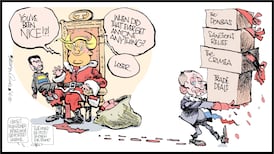"Leave ideology outside the room and let’s start building houses.” That was the response of Taoiseach Micheál Martin last November when Dublin city councillors rejected plans by developer Glenveagh Homes to build 850 houses on a site owned by the council at Oscar Traynor Road in Santry.
The deal would have meant 50 per cent of the homes sold privately by Glenveagh, 30 per cent bought by the council for social housing and 20 per cent sold to workers qualifying for the affordable purchase scheme. No private sales were included in the councillors’ alternative plans. A few weeks later, Central Statistics Office figures revealed that nationally, house prices had increased by 84.6 per cent from their trough in early 2013.
The idea that ideology can be sidestepped in relation to the supply and affordability of housing and the role of private developers is nonsense. The Government, it appears, wants to balance the concerns of developers and freedom of investors with the State’s responsibility to tackle the social crises generated by housing shortage.
This week saw the unveiling of an affordable housing Bill, regarded by the Government as a landmark effort to confront the problem, but it was also the week when, fittingly, we learned that a global investment company was involved in the acquisition of a new development of 112 houses in north Dublin so it can rent them out; the same company that bought most of a 170-home estate in Maynooth, Co Kildare.
Did the Government expect the 'market' would adjust its profit targets by developing a social conscience?
The responses to these revelations have underlined the hollowness of the Taoiseach’s plaintive plea to ignore ideology. Minister for Housing Darragh O’Brien said he did not approve of the scale of the acquisition of these developments by investment funds, but that investors must have a role in housing, and that to try to ban them outright was not an option: “Frankly, this isn’t just a housing issue, we need to see a whole-of-Government approach on this to see why would it be so lucrative for funds like this to bulk purchase properties... The Government would have to look at both the planning and the tax treatment elements of the issue... but it shouldn’t happen at the expense of first-time buyers.”
The Taoiseach then told the Dáil: “We do not want institutional investors competing with first-time buyers.” Tánaiste Leo Varadkar said: “It was never intended” that the investors “would enter into that part of the market... taking away properties that could be bought by first-time buyers.”
It is difficult to take those assertions seriously given that the system as it is now both facilitates and encourages investment companies to make these decisions. Did the Government expect “the market” would adjust its profit targets by developing a social conscience? Suggesting we forget ideology is just a reiteration of the determination to avoid what Enda Kenny described in 2015 as “interference in the market”, a blatantly ideological assertion.
The housing issue presents an interesting study of the ideological compatibility of Fianna Fáil and Fine Gael. When he was interviewed at the weekend, Minister for Public Expenditure and Reform Michael McGrath suggested that delivering affordable housing would be a key metric by which Fianna Fáil’s success in government would be measured, alongside the challenge “to retain a distinct party identity”.
Excessive State transfers, tax breaks and the privatisation of social housing have made for a sorry cocktail that both Fianna Fáil and Fine Gael have vigorously shaken
It is an updated version of a historic challenge. With the advent of self-government, Cumann na nGaedheal identified the housing problem as a priority but only 14,000 houses were built from public subsidy between 1922 and 1929. The following decade, Fianna Fáil tackled the issue more decisively: an average of 12,000 houses a year were built with state aid in the decade 1932-1942, with an obvious employment and social dividend as well as a political one for Fianna Fáil.
The housing drive also enriched many; historian Joe Lee points out that Fianna Fáil’s efforts “naturally proved grist to the pockets of the contractors. Fortunes were made in this field more easily than in manufacturing. The building industry soon came to be widely regarded as an extension of the Fianna Fáil patronage system.”
But at least the party could claim it was fulfilling its social obligations. Fine Gael at different stages was also capable of confronting its responsibilities in relation to housing: in 1948 it called for an “immediate all-out drive to provide houses for the working and middle classes at reasonable rates” and, with the Labour Party, brought a new impetuous to social housing construction at that stage, as it did again from 1973-1977.
A key question now is whether there is a serious appetite in the Department of Finance to meaningfully squeeze investment companies. Excessive State transfers, tax breaks and the privatisation of social housing since the 1980s have made for a sorry cocktail that both Fianna Fáil and Fine Gael have vigorously shaken. They are now, together, in a position to either bring ideology back into the room or to continue to indulge “the market”.










